South Korean research team has developed a technology that allows spin transistors to work normally at room temperature. Spin transistor is an ultra-fast and ultra-low power electronic device that surpasses limitations of current semiconductors. Because it can integrate a memory and a CPU into single chip, it can be utilized to manufacture computers without booting. However its weakness of only working at low temperature has been pointed out as a difficult problem to solve. South Korean research team has prepared an opportunity to solve such weakness.
Korea Institute of Science and Technology (KIST, President Lee Byung-gwon) announced on the 7th that a research team led by Manager Jang Joon-yeon of Next-Generation Semiconductor Laboratory and Professor Park Tae-un of Spin Convergence Research Group has developed a technology that injects spin with high efficiency at room temperature by utilizing GaN (Gallium Nitride) semiconductor nanowire.
Spin is a quantum mechanical property that is related to magnetic property of a substance and rotation movement. Spin transistor is a device that works by utilizing electron’s charge and spin. Its speed is much faster than oxide metallic semiconductor transistor that only utilizes movement of an electron and consumes lesser electricity. However its weakness is that it only works under -200°C.
Research team achieved 10% or higher injection rate of spin at room temperature. Electron spin that was injected was able to move across channel of a semiconductor without huge loss of information even when it moved 1 micrometer or more. Research team has also developed a method that controls signal of injection of spin by utilizing direction of crystal face that is formed from a semiconductor nanowire.
When these technologies are used together, temperature where spin transistor can work can be increased up to room temperature. In order to have spin transistors work at room temperature, injection rate of spin of 10% or higher and relaxation length of spin of 500 nanometers or longer are required. By solving this problem, possibility of commercializing spin transistors has gotten bigger.

When spin transistors are commercialized, nonvolatile ultra-fast, ultra-low power, and ultra-high integration electronic devices that surpass limitations of current semiconductors can be implemented. They are seen as an alternative as it is predicted that current semiconductor devices will face limitations in their performance shortly.
It is also possible to integrate a memory and a CPU into single chip when spin transistors are applied. By using this technology, it is also possible to manufacture ‘computers without booting’.
In 2009, KIST became the first to implement a logical device that utilizes spin transistors. Afterwards it was able to solve a problem regarding temperature, which was seen as the obstacle towards commercialization of spin transistors, through this research.
“Through this research, we have presented a method that will improve working temperature which is the biggest element in development of semiconductor spin transistors.” said Professor Jang Joon-yeon of KIST. “Besides working temperature, we are going to contribute in developing spintronics technology by improving performance of devices and degree of integration.”
Result of this research was published on an international scientific journal called ‘Nature Communications’. This research was carried out from support of Ministry of Science, ICP and Future Planning’s Nano Material Development Project, KIST’s Organization Specific Project, and National Research Council of Science & Technology’s Creative Convergence Research Project
Staff Reporter Song, Junyoung | songjy@etnews.com